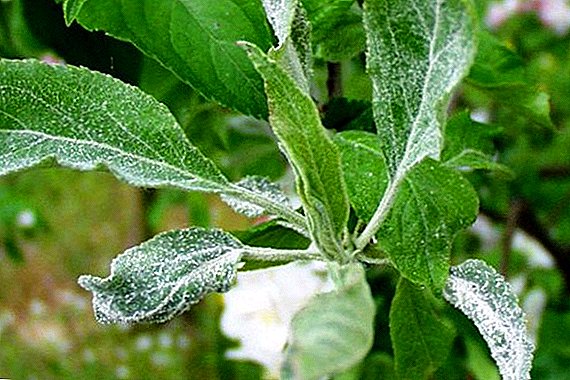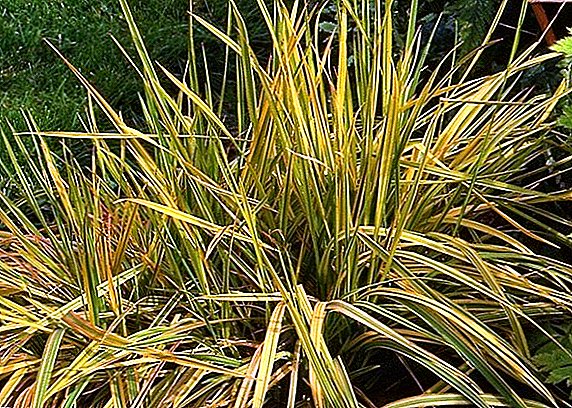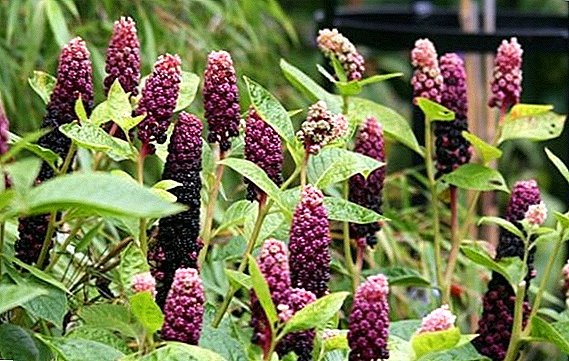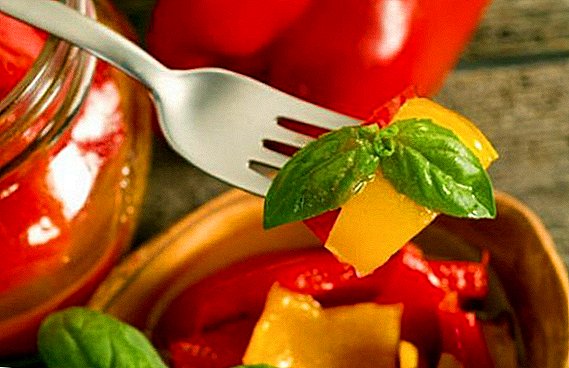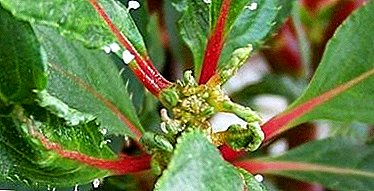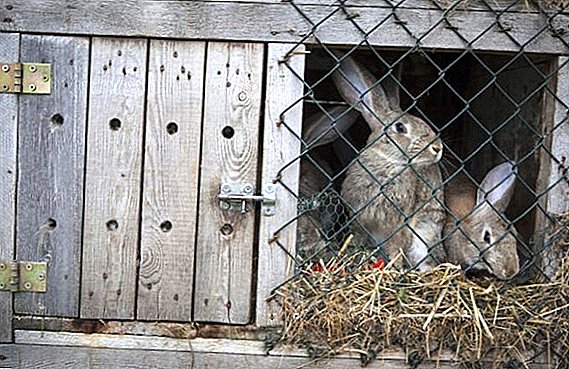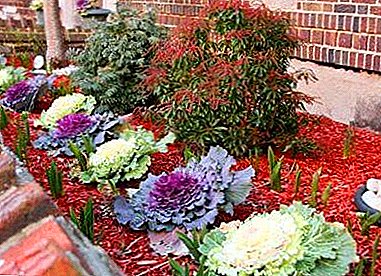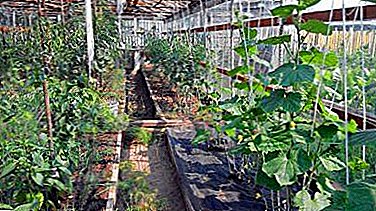
Often, gardeners have to combine in their small area or greenhouse culture with different requirements for care and climatic conditions. One of those are tomatoes and cucumbers.
To get a good harvest when they are planted together, you need to take into account the many nuances that are discussed in this article. It is possible and necessary to plant together, how to act correctly for a good harvest - read on.
Is it possible to plant these crops nearby?
Many gardeners do not recommend growing in close proximity of vegetable crops such as cucumbers and tomatoes. Their incompatibility is quite obvious:
- Homeland cucumber is Ancient India. Like its historical congener, the cucumber prefers sunny, warm, but not very hot weather. Nevertheless, it is very picky about the humidity of the air and the soil. Therefore, this vegetable requires frequent watering. For cucumber, permanent airing and drafts, which are necessary for tomatoes, are destructive.
- According to some sources, Peru is considered the birthplace of tomato. This vegetable is very unpretentious in growing. Only, unlike cucumbers, he does not like frequent watering and abundant sunshine, preferring fresh air and diffused light. Otherwise, the tomato loses its exquisite taste.
What to consider?
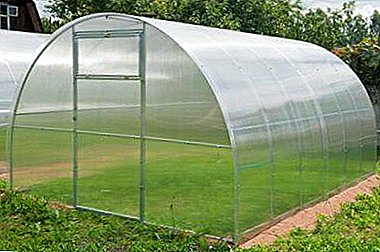 To get a good crop of tomatoes and cucumbers when planted together in a greenhouse, it is necessary to consider the following features of joint cultivation:
To get a good crop of tomatoes and cucumbers when planted together in a greenhouse, it is necessary to consider the following features of joint cultivation:
- The greenhouse should be high and wide enough. Sometimes it makes the second entrance.
- A greenhouse must contain a large number of drains for drafts in the "tomato" department.
You also need to select certain varieties of crops:
- among cucumbers it should be disease-resistant hybrids or varieties that are cool-tolerant;
- for tomatoes, moisture and heat are well tolerated.
It will be better to put the greenhouse in the direction from the west to the east. Thus, the south side of the greenhouse will be well lit.
The feasibility of a joint landing
Growing tomatoes and cucumbers in one greenhouse is very troublesome and difficult. These vegetable crops are absolutely incompatible in their climatic requirements. Constant drafts and coolness can ruin the yield of cucumbers. At the same time, a tomato with a high humidity of the soil and air can die at all.
But there are two undoubted advantages of joint cultivation:
- saving space and sufficient crop yield (although the latter will need some experience);
- As a rule, cucumbers and tomatoes have various diseases.
Cucumber needs
To get a big crop of vegetables, you should observe some conditions:
- Planting cucumbers is at 10-15 degrees of heat.
- The plant and fruits develop better at 25-32 degrees Celsius.
- Cucumber growth stops if the air temperature is below 10 or above 40 degrees.
- Fruits cease to develop at 35 degrees of heat.
- Soil temperature can differ from air temperature by no more than 2-3 degrees.
- Soil moisture should not be below 85-95 percent.
- Soil moisture should be 75-80 percent.
- In dry weather, cucumbers should be watered frequently.
- Young inflorescences in the early stages of growth is not desirable to fertilize. Also it is not recommended to use a large amount of fertilizer to cucumbers growing on sandy soils.
- The acidity of the soil should be neutral or slightly acidic.
Tomato needs
- Planting tomatoes is already possible at 8 degrees Celsius.
- The best temperature for the development of sprouts and fruits ranges from 18-25 degrees.
- Development slows down at temperatures below 15 and above 35 degrees Celsius.
- The tomato is able to withstand up to -1 degrees cold.
- Humidity of air and soil should not exceed 45-60 percent.
- It is necessary to water vegetables abundantly, but no more than 1-2 times a week.
- In the hottest weather, you can water up to 3 times a week.
- Tomatoes like a gentle draft, but do not tolerate wind.
- The acidity of the soil, as for cucumber, must be slightly acidic or neutral.
Matching conditions
The main condition for the combined planting of vegetables is the need for zoning. Moreover, it is desirable to divide not only the perimeter of the greenhouse, in order to be able to create a separate microclimate, but also the soil between the beds. This is necessary to ensure that abundant moisture from watering cucumbers does not fall to the roots of tomatoes. For planting in open ground, tomatoes should also be separated from cucumbers using:
- squash;
- corn;
- beets;
- grapes or any other "harmless" plant culture.
Selection of varieties
For the joint cultivation of such different crops as tomato and cucumber, it is better to choose tomato varieties of high-yielding, disease-resistant and not requiring special care. Among the tomato is.
Waterfall
Tall variety with bright orange fruits. Productivity can reach up to 8 kg.
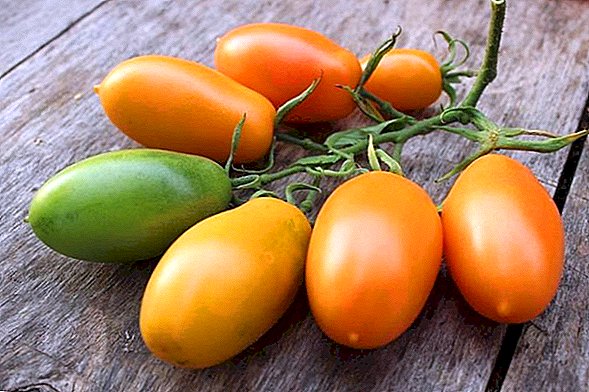
Nastena
For this variety is characterized by large, red, fleshy berries. This species is very resistant to diseases, easily tolerates high humidity and low temperature.
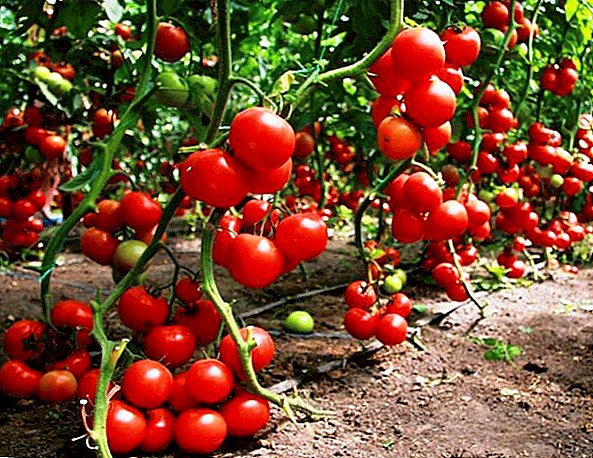
Anastasia
Tall mid-season variety has red or burgundy fruits of medium size. When observing the conditions of care, it gives about 12 kg of crop.
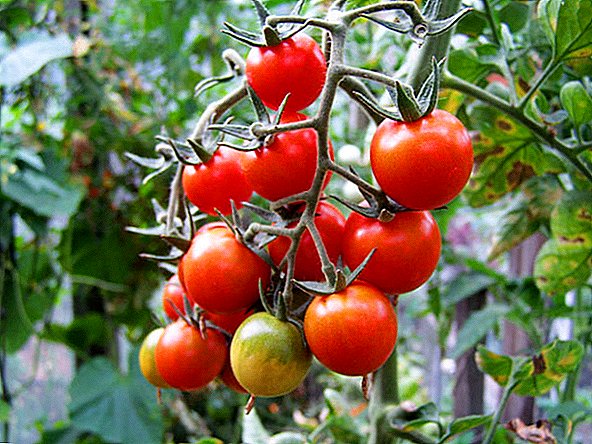
Raspberry giant
The variety is famous for its huge pink hues. The species is resistant to diseases and pests.
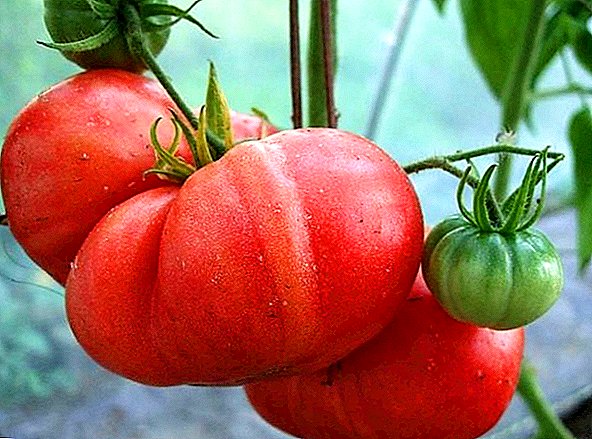
Diabolic
Differs in high growth, to 1.5 meters, and elongated medium-sized red fruits. This species is practically not “sick”.
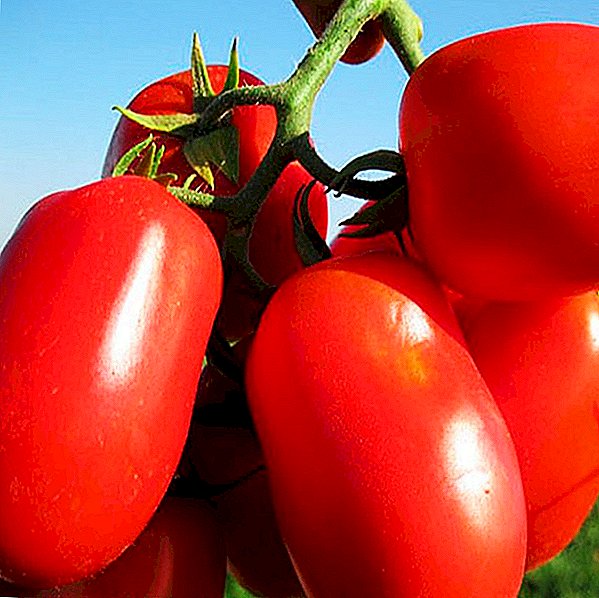
We offer to watch a video about the variety of tomatoes Diabolic:
Samara
A variety of early ripeness with bright red fruits that do not crack. More suitable for greenhouse cultivation.
Before planting seedlings, the soil should be watered with a solution of potassium permanganate.
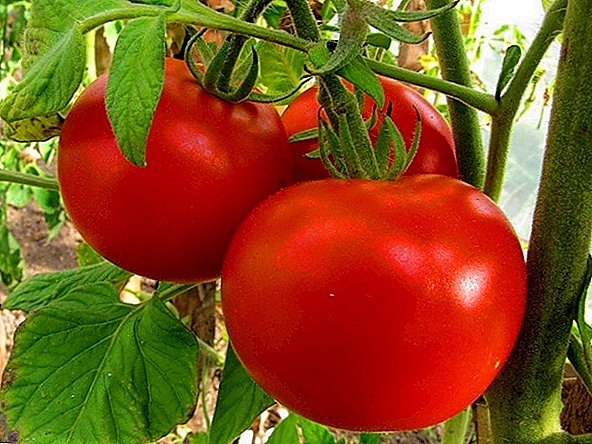
Among the cucumber varieties high yields differ.
Elegant
Tall view of early maturation. Not suitable for canning.
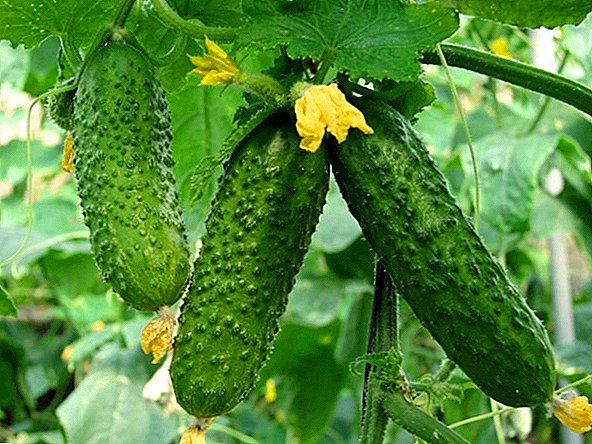
Vyaznikovsky 37
One of the early ripe varieties. Resistant to various infections, including powdery mildew.
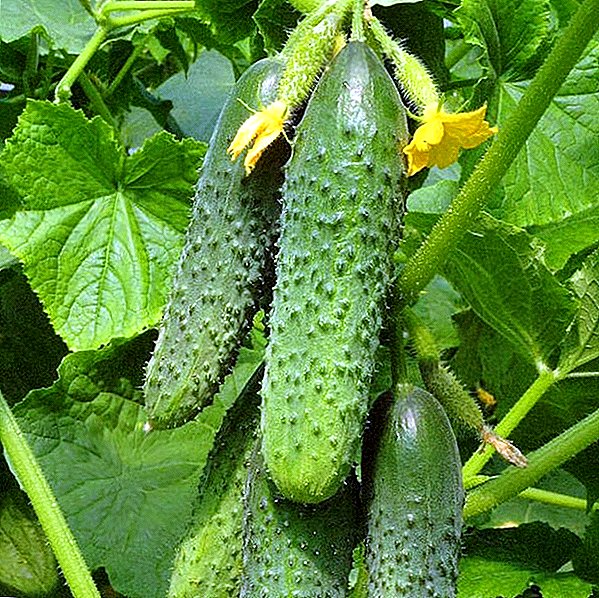
Farmer
A universal look which is suitable both for the greenhouse, and for open landing. He ripens to two months.
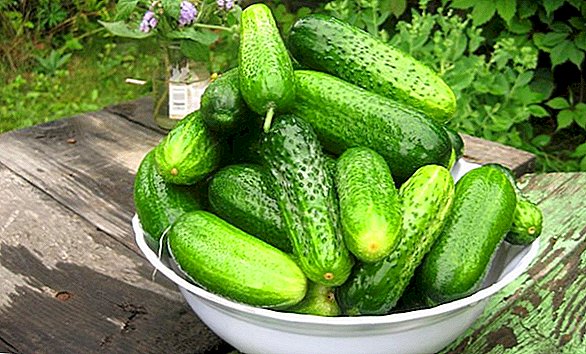
Liliput
High-yielding variety that does not require frequent watering.
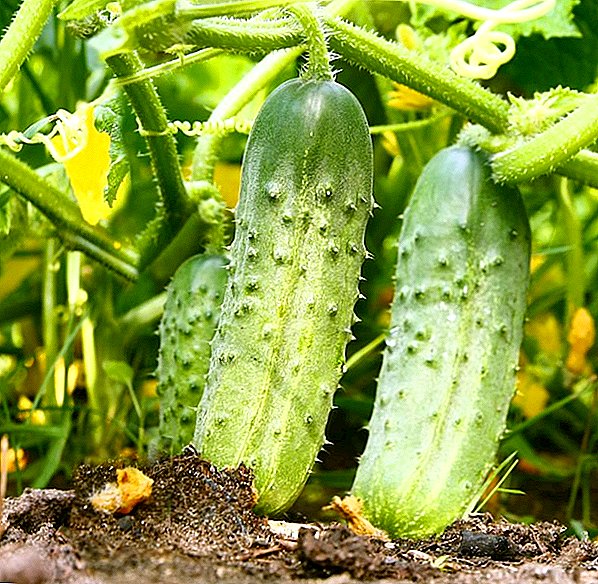
True perfection
Famous for high yields of up to 30 kg per square meter.
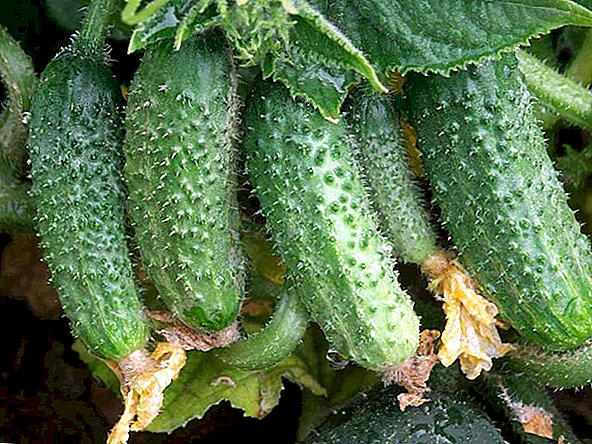
Rodnichok
Usually, gives a high yield and is resistant to diseases. More suitable for greenhouses.
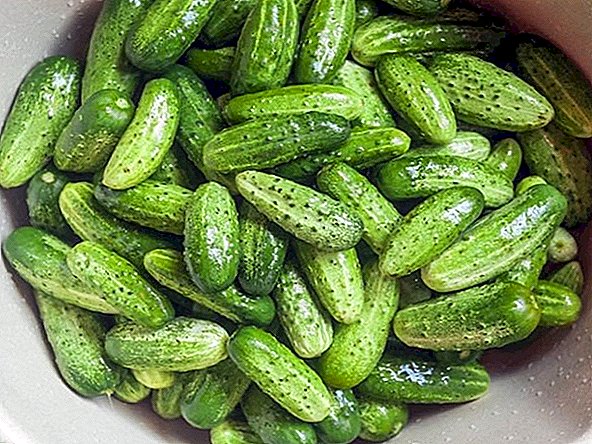
Hermann
Early ripening variety with medium sized large fruits. It tolerates early frosts and is not susceptible to disease. This species does not have bitterness.
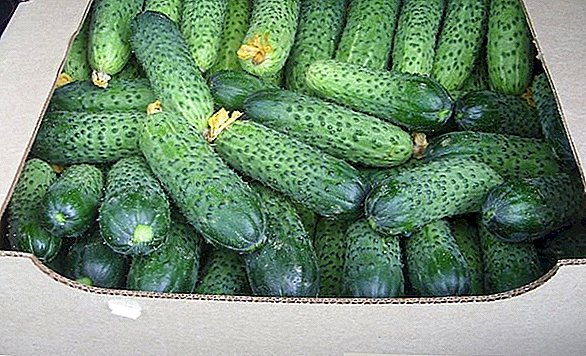
How to properly sow?
A successful harvest depends not only on compliance with all climatic conditions, but also on how to properly plant seedlings previously grown from seeds. Before that you need to properly prepare the greenhouse:
- conduct a complete disinfection (more on how to handle tomato seeds before sowing, read the separate material);
- prepare the ground;
- at the level of 1-2 meters from the garden, pull the tether line;
- form beds in a greenhouse about 40 cm high and about 90 cm wide.
- How should fertilize the beds.
The technique of planting vegetables is not much different from each other. It happens according to the following scheme:
- wells are being dug up in the beds a little larger than a sapling;
- a seedling with soil from a pot is planted in a hole;
- seedlings are planted at a distance of 50 cm from each other in a checkerboard pattern;
- then seedlings are sprayed with a special solution of root rot.
Separation
You can divide the soil between the beds in the greenhouse with the help of an iron sheet along the entire landing. This will help avoid the "flow" of water when watering cucumbers to tomatoes. There is another way to divide the plot. For this you need to create three beds:
- For cucumbers fit the northern part of the greenhouse. It is the coolest and dampest.
- Planting tomatoes is optimal in the middle part, as it is best ventilated here.
- On the southern garden, where there is a lot of sun and heat, you can plant any kind of pepper (how to grow peppers and tomatoes together?).
Zoning
To create your climate, which is required for these vegetables, you need to create an artificial barrier between them. You can stretch the usual food wrap between the beds from the level of the soil to the very top of the greenhouse. Before zoning a room, it is advisable to make another entrance from the opposite side of the greenhouse. This will allow you to easily move from one artificially-created "compartment" of the greenhouse to another.
Hydrogel
Another way to prevent tomatoes from getting excessive moisture when watering cucumbers is to use a hydrogel, which contains polymers. When wet, it absorbs the liquid and increases greatly. Adding it to the soil when planting cucumbers, will facilitate the care of vegetables.
How to care in the greenhouse and on the garden - step by step instructions
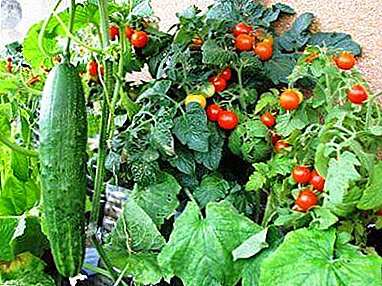 With a full zoning of the site of the greenhouse, care for tomatoes and cucumbers planted together is no different from the usual. To get a good crop of tomatoes, you should:
With a full zoning of the site of the greenhouse, care for tomatoes and cucumbers planted together is no different from the usual. To get a good crop of tomatoes, you should:
- the first two weeks after landing, observe a temperature regime of 20-22 degrees;
- when the sun is too active, the seedlings need to be slightly shaded;
- the first watering is not earlier than 10 after planting;
- watering should be in the early morning or late evening;
- water temperature should not differ from the soil temperature;
- the tomato is watered at the very root;
- after watering a vegetable, the greenhouse compartment needs to be aired;
- it is necessary to provide access for insects and bees for pollination of tomato seedlings.
It is quite simple to care for cucumbers in the beds, you need to follow only a few rules:
- young seedlings watered with warm water, about 25 degrees;
- after watering the greenhouse, it is desirable to ventilate, not allowing drafts;
- when the first ovaries appear, the temperature in the greenhouse needs to be raised to 28 degrees;
- so that the plant does not grow, you should make timely pinching.
Hydrogel - water substitute
This polymer crumb will help to avoid frequent watering of vegetables, how much easier to care for them:
- 10 grams of hydrogel will need about 3 liters of water;
- before planting a seedling a small amount of polymer is added to the well;
- then, plant the plant to powder ½ cup of the finished gel;
- it is possible to dissolve a crumb, both in water, and in weak solution of organic or mineral fertilizer.
Mulch to retain moisture
Another way to facilitate the care of vegetables - zamulchirovanie. The beds seem to be “covered” with a layer of cut grass or weeds at the level of 8 cm, which is added as it dries. Mulch retains moisture, which reduces the amount of watering. In addition, rotting, the bottom layer of such a blanket retains heat, so important for cucumbers.
Top dressing
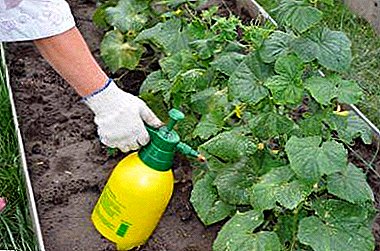 One of the most important conditions for high yield of vegetables is the correctly chosen fertilizer. It helps plants to be strong and resistant to bad weather or disease. What is the best way to fertilize cucumbers:
One of the most important conditions for high yield of vegetables is the correctly chosen fertilizer. It helps plants to be strong and resistant to bad weather or disease. What is the best way to fertilize cucumbers:
- The first feeding is done two weeks after planting. A liter of slurry is diluted in 8 liters of water and inflorescences are sprayed on the beds.
- The second time the vegetable is fertilized during its flowering period. To do this, in 10 liters of water you need to dilute 1 tablespoon of ash and spray cucumbers.
- The third time is made dressing when ripe fruit. For this, the gum preparation is well suited for use - 2 liters per 10 liters of water. Spray should be the roots of the plant.
- The fourth vegetable fertilizer allows you to extend its fruiting.
Important! Stop feeding cucumbers need for 2-3 weeks before harvesting.
Fertilization of tomatoes occurs with the help of special mixtures, which are then poured on the roots of plants:
- Top dressing is carried out in early June. To prepare the solution will need:
- 1 tablespoon nitrofoski;
- 0.5 mullein;
- 0.5 teaspoon of boric acid;
- 2 tablets of micronutrients;
- 10 liters of water.
- Fertilizer is applied in the first days of July. To prepare the mixture you need:
- 2 tablets of micronutrients;
- 0.5 mullein;
- 1 tablespoon of potassium sulfate;
- 10 liters of water.
The fight and the prevention of pests and diseases
Like many other plants, cucumbers and tomatoes are subject to various diseases and attacks of insects.
- Pests often settle on weeds growing in close proximity to vegetables. Therefore, it is necessary to remove excess grass from vegetable beds and around the greenhouse.
- Periodically, cucumbers and tomatoes should be treated with special solutions that make the plants unattractive for insects.
- Also, the timely removal of diseased leaves will help to avoid the complete death of plants.
Nevertheless, if the territory of a kitchen garden allows or there are two greenhouses, it is better to grow cucumbers separately from tomatoes. Or choose more compatible with each of them plants and vegetables. For example, cucumbers perfectly “feel” themselves next to peppers or legumes, and tomatoes more “prefer” the neighborhood with white cabbage.


